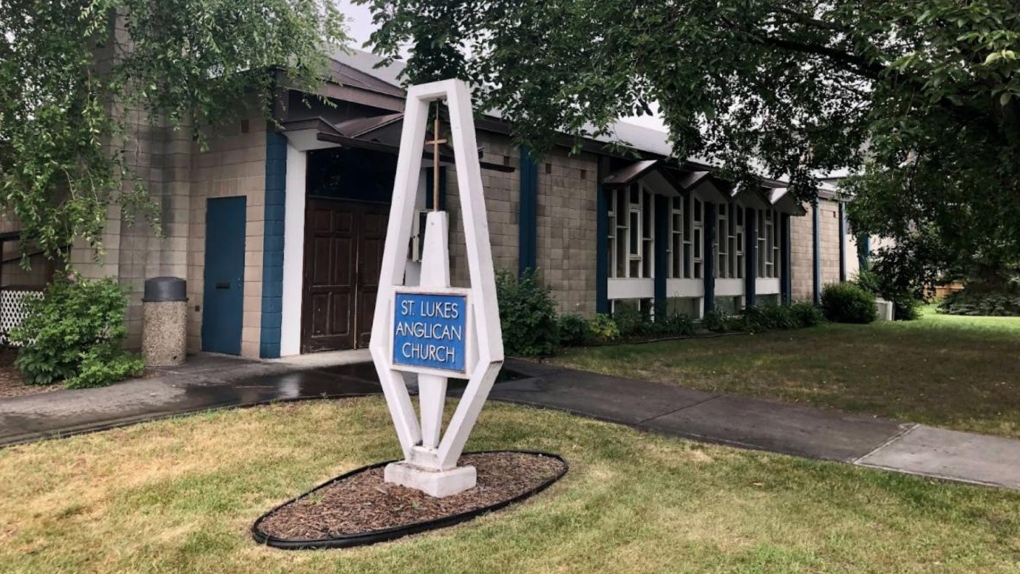This Edmonton church has been designated a historic resource because of its architecture
 St. Luke's Anglican Church. (Source: Edmonton.ca)
St. Luke's Anglican Church. (Source: Edmonton.ca)
An Edmonton church has been designated a historic resource by the city.
St. Luke’s Church in the Holyrood neighrbourhood was built in 1958.
According to the city, it was one of the first churches to veer away from the influence of medieval ecclesiastical design to a more modern look.
The church features an exposed, precast concrete structure that forms the roof of the sanctuary, concrete block masonry for the walls, and a concrete block bell tower.
A parish hall was added in the 1970s.
“The post-war years changed how people lived in Edmonton,” said heritage planner Scott Ashe in a written release. “They had survived war and the depression. They had jobs and cars and wanted their families to spread out in the suburbs. They wanted to live away from where they worked, but still worship in their own communities. St. Luke’s is indicative of the kind of modern church built in those times.”
The church was designed by Edmonton architect Kelvin Crawford Stanley, who was active in the city between 1948 and 1964.
He worked as the director of structures for Expo 67 in Montreal, then served as chief architect with the federal department of public works.
He died in 1995 in Sidney, B.C.
As part of the heritage designation, the church has received a grant of $50,375.77 to rehabilitate the building.
“Today the St. Luke's building is home to three separate faith communities, a small Indigenous owned and operated business, community league events, a weekly food bank depot, and many other groups and events,” said Rev. Nick Trussell, Rector of St. Luke’s Anglican Church. “Historical designation protects the unique story and beauty of the building, its design and construction.”
The city’s Historic Resource Management Plan outlines a plan to protect and promote the preservation and use of historic resources.
Since the plan was initiated in 1985, 176 properties have been designated as historic resources.
CTVNews.ca Top Stories

Walking pneumonia is surging in Canada. Is it peaking now?
CTVNews.ca spoke with various medical experts to find out the latest situation with the typically mild walking pneumonia in their area and whether parents should be worried.
Minister calls GST holiday, $250 cheques for 18 million Canadians 'a targeted approach'
Women and Gender Equality and Youth Minister Marci Ien is calling the federal government's proposed GST holiday and $250 rebate cheques a 'targeted approach' to address affordability concerns.
'Her shoe got sucked into the escalator': Toronto family warns of potential risk of wearing Crocs
A Toronto family is speaking out after their 10-year-old daughter's Crocs got stuck in an escalator, ripping the entire toe area of the clog off.
NEW Thinking about taking an 'adult gap year'? Here's what experts say you should know
Canadian employees are developing an appetite for an 'adult gap year': a meaningful break later in life to refocus, refresh and indulge in something outside their daily routine, according to experts.
'Immoral depravity': Two men convicted in case of frozen migrant family in Manitoba
A jury has found two men guilty on human smuggling charges in a case where a family from India froze to death in Manitoba while trying to walk across the Canada-U.S. border.
Prime Minister Trudeau attends Taylor Swift's Eras Tour in Toronto with family
Prime Minister Justin Trudeau is a Swiftie. His office confirmed to CTV News Toronto that he and members of his family are attending the penultimate show of Taylor Swift's 'The Eras Tour' in Toronto on Friday evening.
Ancient meets modern as a new subway in Greece showcases archeological treasures
Greece's second largest city, Thessaloniki, is getting a brand new subway system that will showcase archeological discoveries made during construction that held up the project for decades.
Quebec man, 81, gets prison sentence after admitting to killing wife with Alzheimer's disease
An 81-year-old Quebec man has been sentenced to prison after admitting to killing his wife with Alzheimer's disease.
Canada Post quarterly loss tops $300M as strike hits second week -- and rivals step in
Canada Post saw hundreds of millions of dollars drain out of its coffers last quarter, due largely to its dwindling share of the parcels market, while an ongoing strike continues to batter its bottom line.


































